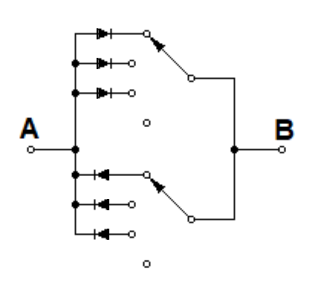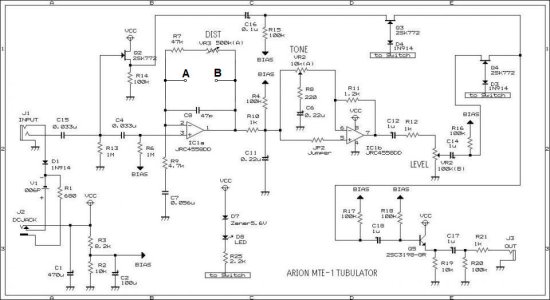You are using an out of date browser. It may not display this or other websites correctly.
You should upgrade or use an alternative browser.
You should upgrade or use an alternative browser.
Pedal Builder Question
- Thread starter idsnowdog
- Start date
Artie
Peaveyologist
I think I might approach this from a slightly different angle. I'm guessing that your prime concern is trying different diode combinations. So, rather than start with a kit, start with a known commodity that works and sounds good, and can be had inexpensively when bought used. Like an old DS-1 or SD-1, even an Arion Tubulator. Whatever you decide, what I describe next will work equally well with either approach.
Almost all distortion pedals use two diodes back-to-back, either in the output section, or negative feedback section of the circuit. In both cases, you're dealing with simply two points on the circuit board. Here's the schematic for the Tubulator that shows this. The Tubulator uses the NF technique.

Almost all distortion pedals use two diodes back-to-back, either in the output section, or negative feedback section of the circuit. In both cases, you're dealing with simply two points on the circuit board. Here's the schematic for the Tubulator that shows this. The Tubulator uses the NF technique.

Artie
Peaveyologist
Now, simply build a little board with a couple of rotary switches, or jumpers, so that you can quickly "switch" in different diodes. It's good to have different rotary's for both diodes because there's something to be said for asymmetrical diode clipping. Including, one side having no diode. That's totally up to you. And maybe use turret terminals so you can even do quick-change diode soldering. A DPDT switch could let you do quik A/B testing. Here's an example with a two SP4T rotary switches. You get the idea.


idsnowdog
Imperator of Indignation
I already have an Asmuse Ultimate Drive which is an OCD clone which I have modified by adding a 1N4148 silicon diode to the stock Germanium diode but since it already sounds much better than stock I'm hesitant to mod it any further. I also have a mini tube screamer but that uses SMD components and isn't practical to modify. The DOD 250 looks to be the simplest diode clipping circuit and I would like to have two multi-position rotary switches so I can get different combinations of symmetric and asymmetric clipping.
Artie
Peaveyologist
How exactly is the stock YJM308 different from a DOD 250, anyway? I thought the 308 was supposed to be a clone of his favorite 250.
You'd have to look at the Monte Allums parts list. It's a cap or two. A diode or two. An IC. And the most important tonal change . . . the size of the knobs.
https://www.monteallums.com/pedal_mods_DOD.html
idsnowdog
Imperator of Indignation
The Ultimate Drive I have is an asymmetric clipper with a Germanium diode stock. I added a silicon diode because I thought it sounded too dark and soft. The silicon diode gives a brighter harder clipping which compliments the Germanium well. So it's almost a semi-symmetric clipping since the two diodes don't clip in the same way.Now, simply build a little board with a couple of rotary switches, or jumpers, so that you can quickly "switch" in different diodes. It's good to have different rotary's for both diodes because there's something to be said for asymmetrical diode clipping. Including, one side having no diode. That's totally up to you. And maybe use turret terminals so you can even do quick-change diode soldering. A DPDT switch could let you do quik A/B testing. Here's an example with a two SP4T rotary switches. You get the idea.
One of the clipping mods I am most anxious to experiment with is the Jose Arredondo Zenner diode clipping circuit. I see it in amplifiers a lot but I can't find a pedal that uses them? A blue LED and a Schottky diode would also be an interesting combination because the two clip very differently.
Artie
Peaveyologist
One of the clipping mods I am most anxious to experiment with is the Jose Arredondo Zenner diode clipping circuit.
I'll have to "google" that. Sounds intriguing.
Also check out runoffgrovve.com's "Bazz Fuzz" circuit. Super simple build, and if you scroll down, they talk about the affect of different diodes.
http://www.home-wrecker.com/bazz.html
(home-wrecker is the old sideline of runoffgroove.)
Erlend_G
New member
I've decided to try build my own fuzz "clone kit", when time arrives.
Preparing a hobby room, DIY place. With a good Wellerman soldering iron, etc.

Cool to have access- to the almost unlimited!! amounts of parts, switches, etc. And diagrams!
...just a slight touch-up of my electronics (functional calculus) knowledge. And I'm off for my first creation.
The EGA #1, passive tone/volume module. So far. With maybe added gain stages & different witchcraft!
-E
Preparing a hobby room, DIY place. With a good Wellerman soldering iron, etc.
Cool to have access- to the almost unlimited!! amounts of parts, switches, etc. And diagrams!
...just a slight touch-up of my electronics (functional calculus) knowledge. And I'm off for my first creation.
The EGA #1, passive tone/volume module. So far. With maybe added gain stages & different witchcraft!
-E
idsnowdog
Imperator of Indignation
Basic theory:I'll have to "google" that. Sounds intriguing.
Also check out runoffgrovve.com's "Bazz Fuzz" circuit. Super simple build, and if you scroll down, they talk about the affect of different diodes.
http://www.home-wrecker.com/bazz.html
(home-wrecker is the old sideline of runoffgroove.)
https://www.youtube.com/watch?v=FJqjbXazLqM
Modded Marshalls:
https://www.youtube.com/watch?v=2GKnchpztN0
https://www.youtube.com/watch?v=RKvI7TIsnf8

